
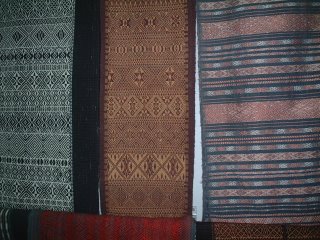

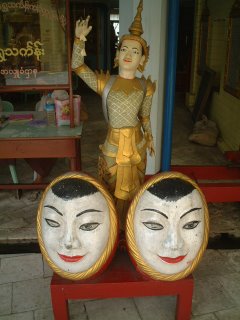
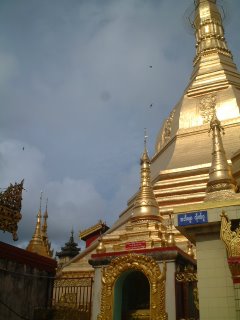




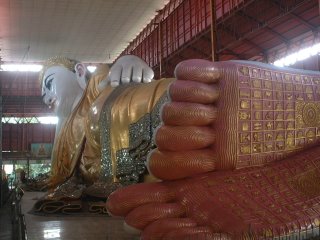
September 26, 2006
Another couple of weeks have glided by here, leaving barely a ripple in their wake. The monsoon rains have returned with a vengeance, although this time bringing occasional thunder, a sure sign according to the Burmese that the monsoon will soon be over. There are still occasional sunny days, but most days are grey again, dampening the spirits.
Just after writing my last entry, I had the misfortune of stepping on a nail while running. It was the classic rusty nail, and it poked right through the sole of my runner, throught the sole of my foot and out the top of my foot. Miraculously, it missed any tendons, arteries, bones, ligaments, nerves or muscles that it could have severed, and after an exceedingly painful tetanus booster, it seems to have healed well, with no infection. I was on a residential street at the time, and the inhabitants of the nearest house ran out when they heard me howling in pain and helped me, pulling the nail out, bathing the cut in lemon juice, then water, then Betadine, and finally loading me into a taxi and sending me home. As always, I was impressed with the helpfulness and generous hospitality of people here. The visit to a local clinic cost 2100 kyat for the doctor (about $1.50) and 3000 kyat for medicines and the tetanus booster (another $2.20). It could have been much worse, and I’m already back to running.
It was good to see my friend Ray as he and his girlfriend Akiko passed through town that weekend. He fired us up to do our own exploring of the hinterland starting next week, and wowed us with his array of magic tricks; he even left us with one to use for ourselves. This weekend we’re on a visa run to Bangkok, with a side trip to Kanchanaburi to see the remarkable tiger temple there. After that, we’ll be off the following Thursday afternoon to Bagan, the huge ruined capital city in central Burma, and then Inle Lake, the beautiful lake nestled in the mountains of Shan State.
I can’t wait. Much as teaching here has been fun, it’s still a job and it still ties us down, preventing us from seeing much of the country. I’ve been reading up on various bits of the country that I really want to visit, and getting quite excited to see new sights. I chatted with a man from Chin State who runs a handicrafts store in the main Bogyoke Market and was once again reminded how much I would like to visit this hard-to-get-to corner of the country, full of medium-sized mountains, head-hunting tribes and ethnic and cultural diversity.
Yesterday, for the first time, I ventured out of the school at lunchtime to eat at a local food stall on the street corner next to the school. The Burmese language teacher and a security guard were there as well, and I settled in for a meal of rice, fish-ball curry, vegetables and a water-spinach soup. It was very reminiscent of the meals I had most days in northern Vietnam, except that it was even cheaper; only 400 kyat ($0.30). I can’t believe that it’s taken me this long to sample the street cuisine here; I’ve allowed myself to be trapped in a strange expatriate bubble of (relatively) expensive restaurants and taxis, rather than my usual street-food-and-public-transport exposure to a country. I haven’t even learned the numbers in Burmese, a sign perhaps of how much basic English is spoken here, but also a sign of how little I’m really trying to get into this country and its culture. Having come to this realization, it’s time to start taking Burmese lessons and learning to decipher the delightfully bubble-like alphabet. On the weekend I purchased an oversized poster of the Burmese consonants (all 33 of them) to hang on my wall for contemplation. Now I need another chart for the 36 different combinations of vowel sound, tone (3 of them), nasalization and glottal stopping, and I’ll be ready for reading.
Joanne and I were discussing the other day why the streets seem less frenetically crowded and miserable than in your average Indian city. We decided that the near-absence of beggars (although I’m starting to notice them more often here and there; the fear of the police, enforcing anti-vagrancy laws, may play a big part here), the lack of people sleeping out on the streets at night and the relative scarcity of children (Burma is said to have one of the lower population growth rates and lower fertility rates in underdeveloped Asia) make it easier to be on the streets here. As well, Buddhism plays its part, as it seems to make for a less in-your-face culture than Hinduism. Although the British administered Burma for 50 years as part of the British Raj, Burma has largely retained its distinctive culture and feel. Despite the number of Indian immigrants to Rangoon, there is little of the atmosphere of India here. Partly that may be due to the government’s coercive Burmicization policy, whereby in order to get any access to telephones, government documents and services, everyone, whether Burmese, Indian, Chinese or tribal minority, has to adopt a Burmese name.
I would like to close with a recurring vignette from my 8th-storey bird’s-eye view of the neighbourhood. I love standing at my classroom window watching the trains run past the school on the main Rangoon-Mandalay line. The freight trains are always loaded down with people, hoboes hitching a lift into town from the countryside for work; sometimes a single 10-car train will have over a hundred non-paying passengers sitting on it. The passenger trains, especially the big ones headed up-country, are another attraction, as they exude the freedom of the road to those of us trapped in the 9-to-5 routine. My favourite, though, are the occasional steam engines chugging by, hauling freight cars. Unlike steam locomotives in most of the world, these are not tourist attractions; these are working train engines chugging by with the distinctive chug-a-chug-a rhythm of The Little Engine Who Could, punctuated by the evocative strains of a steam whistle. The steam locomotives are Burma in microcosm: once the last word in prosperity and state-of-the-art modernity, now an amusing and charming anachronism in which time has barely budged since independence in 1948.
September 28, 2006
Yesterday the monsoon started to retreat, I think. Suddenly the prevailing winds shifted 180 degrees and began to howl. The air suddenly felt drier, and various middle-aged teachers began complaining that their joints were beginning to ache, a sure sign of changing weather (or so I’m told). It’s amazing how definitive a change it seemed to be; although it’s still raining, there’s an air of finality about the monsoon.
Off to Bangkok today for a visa renewal run, a trip to the tiger temple in Kanchanaburi and some general rest and relaxation. I shall post this there.
Happy Reading!
Graydon


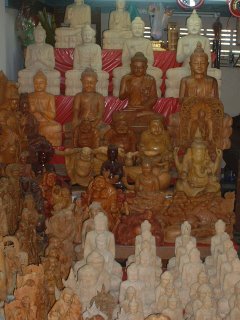

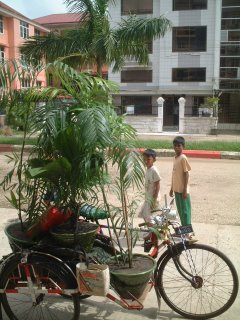

September 14, 2006
It’s been three and a half weeks since I last wrote, although this might not get posted for some time yet, depending on the status of access to Blogger. Since I last put fingertips to keyboard, the big news is that the monsoon rainy season has apparently ended early. Although it still rains from time to time, it’s far less frequent an occurrence, and between showers we get periods of hot, sunny weather, clear skies, distant views of towering cumulo-nimbus and stunning sunsets. It’s wonderful to be able to look up at night and see stars, something we couldn’t do for the first five weeks of our sojourn here. It lifts the spirits to look out to blue skies, rather than to an uninterrupted curtain of grey. Strangely, the monsoon only came to Assam, the Indian state neighbouring Burma, on August 29th; only one range of hills separates monsoon-drenched Assam from drying-out Burma.
We have yet to venture beyond the boundaries of Rangoon on the weekends. Only now that we are coming out of our monsoon-induced hibernation are our thoughts turning towards getting out to explore more of the country. My colleague Ray, with whom I was recently teaching in Japan, is on his way through the city tomorrow with his Japanese girlfriend; they will likely be our first overnight guests at our grand mansion. I’m sure that talking to him about Inle Lake and Bagan and the hill country beyond Mandalay will just fuel our wanderlust to see more of this strange and wonderful land.
I’ve continued my weekend bicycle jaunts with my colleague Viola, heading out into the countryside beyond the triangular riverine confines of the city. It’s a wonderful city for biking; traffic is nowhere as busy as in most of the rest of Asia, and on the secondary roads and back streets the only competition for road space is other bicycles, trishaws and pedestrians. For a city of 5 million people, Rangoon really feels like an oversized village. Just 5 minutes’ run from my front door is a large settlement of bamboo huts that could have been lifted from any village in the country, rather than from a major suburb of a national capital. There is none of the frantic rush that characterizes so many major Asian cities; in fact, there is little to indicate that we are in the year 2006. The buses date from the days of the Raj, at least in design, although they have been retrofitted to burn compressed natural gas. Because of draconian police restrictions, there are no motorcycles on the streets of Rangoon, nor are there any of the blaring horns that bedevil the roads of India or Vietnam. We ride a 30-km loop, stopping off to eat watermelon and take pictures, and it’s the best way to see life here off the main thoroughfares.
I love the street scenes we come across while cycling or while I’m out running. Stately processions of monks make their way down the road, begging bowls held resolutely forth, their crimson robes shining bright in the unaccustomed post-monsoon sunlight. Trishaws trundle by with shrill sounds of bells, carrying plump matrons, schoolgirls, monks or office ladies. There is the over-amplified clamour of the lottery man or the monastery fund-collectors, or the roar of the occasional car or truck long overdue for an engine overhaul. The women in the street are dressed in long tube skirts of striking silk designs and sporting face masks of yellow thaunaka paste that makes them look completely alien. The men all wear longyi skirts and frequently have a massive chaw of betel-nut in their mouths which stains their lips and teeth a preternatural shade of red, giving them a vampirish air.
Despite being a city of, apparently, 6 or 7 million people, most of Rangoon feels like a large, sprawling village. Only a few minutes on foot from my house, past a Beverly Hills-like subdivision, lie vegetable gardens and bamboo huts. Between the major streets, large blocks of green land remain. Only in the downtown area is there a feeling of unremitting urban development, mitigated there by the frequent splashes of colonial grandeur. For the most part Rangoon has less traffic, noise, pollution and concrete than most Asian cities, which is A Good Thing.

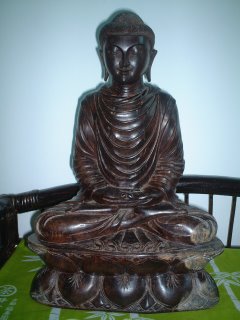
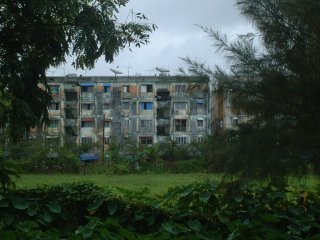



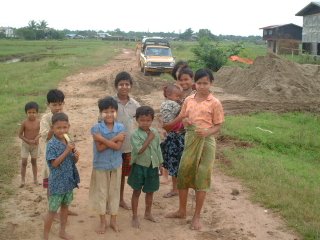

August 24, 2006
It’s hard to believe that almost a month has flown by since I last wrote. Work, adjusting to the different pace of life as a teacher, jet lag and general tiredness have made the time slip by quickly without necessarily leaving a memorable trace. It’s all too easy when working to avoid any of the more intense, interesting and educational experiences that await us when we’re traveling and encountering new environments and people and experiences every day. Particularly living as we do, in a little self-contained world of expat teachers and apartments right across the street from the school, it’s too easy to ignore the fascinating world outside our doors.
The torrential downpours don’t help, making us feel like hibernating indoors. It rains most days still, and every few days we have an afternoon storm straight out of Genesis. I’ll be teaching up in my 7th floor eyrie and I’ll look outside and see the sky as dark as twilight with curtains of rain blown in on powerful winds from the Indian Ocean. In a few minutes it will be upon us, assaulting our concrete tower with primeval force and forcing rainwater through cracks in the wall and openings around the edges of windows. I love watching storms like this, feeling very small and insignificant. One of my math classes did a calculation of how much water falls on Rangoon in a cloudburst like this. Assuming the surface area of the city to be about 500 square kilometres, we came up with a figure of 100 million tons of water falling in a storm which deposits 2 cm of rain on us, a not unreasonable figure given the ferocity of the rain. After an hour or two the rain will peter out, leaving our neighbourhood ankle-deep in water for the next day or so. Rangoon is built on the marshy land of the vast Irrawaddy Delta and the water table is never far from the surface, so a good rain completely saturates the soil right to the surface.
We live in Thingangyun township, about 10 km by road northeast of downtown. It’s a fascinating concatenation of opulent mansions that look to have been plucked out of Beverly Hills and dirt-poor neighbourhoods of bamboo shacks crowded cheek by jowl, surrounded by open sewers and piles of rubbish. Walking or running through these areas my senses are overwhelmed with all the sounds, sights and especially smells, both pleasant and noisome, of the Indian subcontinent: spices, incense, food, garbage, sewage. It’s amazing how quick the change from slum to suburban palace occurs, sometimes within half a block. The slums in our neighbourhood seem to house a disproportionate number of Indians, whose darker skin and pointy features stand out from the rounder, flatter, more Mongolian faces of the Burmese majority. We live a few hundred metres from the main Rangoon-Mandalay train line, and, as always, the train tracks seem to attract squatter settlements aplenty.
The train line is relatively busy, with a number of passenger trains chugging past the school every day. I really want to take a night train to Mandalay some weekend soon, spending Saturday and Sunday in and around the old capital and then taking another night train back just in time for school on Monday. I’ve been watching, and the trains seem to leave on time and, most of the time, arrive in Rangoon on time as well, so it’s doable. Once the rains abate……
In most Buddhist countries right now is the rainy season, and Buddhists traditionally have a rainy-season meditation retreat in which the monks and teachers stay put for the duration of the monsoon, praying and fasting (the Buddhist Lent is a name I’ve heard applied here). This is a good idea, but it has a very unfortunate corollary here. Last Saturday I heard a noisy procession making its way down our street, led by a monk with one of the resonant flat chimes, shaped like the silhouette of a bell, which all monasteries have here. He was followed by a number of figures in sombrero-sized bamboo hats with collection jars and, ominously, a loudspeaker. Megaphone man kept up a droning appeal for donations as they walked from door to door and street to street. I saw them again on Sunday during the day. On Tuesday night, though, a man with a megaphone began blaring the same litany at 3:00 am at the volume of a typical Motorhead concert. He was outside the monastery which lies over our garden fence. It was a bit like having monks in bed with us. Even with earplugs in, it was deafening. The teachers who were here last year tell me that the din only gets worse and more frequent until the end of the rainy season in the middle of October. I can only wait. The usual night noises of monks gonging bells and chanting (unamplified, luckily) and the resultant howling of the myriad stray dogs is finally fading into the background for me and no longer wakes me up much, but I don’t think that 110 decibels of begging can be ignored. It seems to me a counterproductive tactic to wake people up to importune them for cash; it’s hardly likely to make them kindly disposed to your patter. I fell as though I’m trapped in a never-ending NPR end-of-financial-year fundraising marathon, only without the nonstop broadcasts of Fawlty Towers and the Hitchhiker’s Guide to the Galaxy.
My blogging has been curtailed by the government here, who blocked the Blogger login page two days ago. I was pleasantly surprised to find the page unblocked and usable when I got to Burma, since most free web-based communication tools (GMail, Hotmail, Yahoo Mail, Skype, Yahoo Messenger, Geocities) are blocked; I guess that Big Burmese Brother has cottoned on to the existence of Blogger. It just means that I will have to post while out of the country on my every-10-weeks visa runs.
So far Joanne and I have seen little of Rangoon. Despite staring at Shwedagon Pagoda every day from my office (and an impressive sight it is, even 7 km away, dominating the skyline), we haven’t even gone in there despite our best intentions. We have spent our weekends furnishing our flat with impressive quantities of potted trees and plants and rattan furniture. I think our acquisition phase is almost over, though, as we don’t have much more space to put new furniture nor Burmese kyat to pay for them. We’re living in some style, in a better-furnished place than I’ve ever lived in, I think. A set of decent stereo speakers and we’ll be set, other than putting some photos on the walls. The plants make a big difference, giving a lived-in jungly feel to the place. I hope that they survive being kept indoors, given how much we’ve spent on them!
We have visited the nearby Reclining Buddha a couple of times. He’s an impressive size and I really like the realistic, expressive blue glass eyes. Joanne really likes the wood carving and laquer-ware shops clustered around it, and we have bought a number of nice carvings and bells and a lovely bloodwood Buddha there. I really like the Buddha and so, after initial apprehension, does Joanne. He’s a uniquely Burmese depiction of the Buddha, with straight hair and a high-collared monk’s cowl that looks as though he stole it from a Franciscan friar. He sits in our entrance hall with a serene expression on his face, a nice reminder of Buddhist calmness and non-attachment as we scurry frantically out the door in the morning, trying not to be late.
The extraordinary friendliness and courtliness of the Burmese is wonderful to encounter. There’s little of the hustling and rip-off-the-foreigner feeling of, say, Bali or Bangkok or Rajasthan (aside, inevitably, for the taxi drivers). When I go into the local market, I get charged, as far as I can tell, local prices, which are really low, even by Southeast Asian standards. Having run out of glue, I had a bike tire patched the other day for 200 kyat (15 US cents) and had a shave for 250 kyat. Rice sells wholesale here for 200 kyat a kilo, although we pay 500 in the supermarkets. One of the only really expensive things here are mobile phones (sold by the government monopoly for the ludicrous sum of US$1000, or on the black market for $2000) and cars (a 20-year-old clapped-out pickup truck will still set you back $12,000, and I saw a 1997 Honda Accord for sale for a whopping $50,000). As foreigners, we have to pay artificial rates for hotels, domestic plane tickets and train tickets, but we pay the going rate for everything else, including buses, which means that foreigners who are watching their budgets ride buses a lot.
I’m looking forward to the end of the rains in mid-October. We will have a 10-day break then and I think Joanne and I will head north to Mandalay and the ruined cities in the vicinity before making the pilgrimage to Bagan, one of the three great ruined cities of the Indianized states which dominated Southeast Asia until 600 years ago. (The other members of the Ruined Trinity are Borobodur, on Java, and Cambodia’s Angkor.) After that I want to get out of town a lot on weekends, and I’m scouring the Lonely Planet for ideas. Sadly there are no domestic flights leaving Rangoon after 3 pm, which cuts down on the chances of weekend flying jaunts around the country.
I must go to bed, but I will write more soon, and will post this in Bangkok at the end of September when we go on our first visa run out of the country.
























